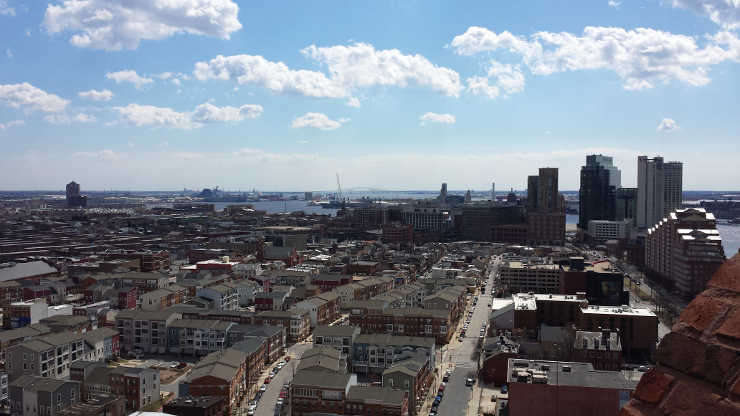
Jonestown is Baltimore’s oldest and most historic neighborhood. Its origins go back to 1661, when the region’s first European settler, an Englishman named David Jones, built a house on the east bank of the stream that would later take his name, the Jones Falls . Baltimore Town was founded in 1729 on the west side of this stream. Three years later, a group of enterprising individuals created a rival town to the east. They laid out Jones Town in 1732, naming it, like the stream, for David Jones. After the Gay Street bridge linked the two towns, it became clear their destinies were intertwined, and they merged together in 1745. Jones Town became commonly known as “Old Town”— its original name not to reemerge until more than 200 years later.
Because the neighborhood was a slight distance from the city’s busy ports, wealthy Baltimoreans settled here in the late 18th and early 19th centuries. The Carroll Mansion (c. 1811) was home to a signer of the Declaration of Independence; the second mayor of Baltimore lived at Nine North Front Street (c. 1795). The community also contained a variety of tradespeople and artisans. At the Flag House (1793) on Pratt Street, Mary Pickersgill sewed the flag that inspired Francis Scott Key to write “The Star Spangled Banner.”
As the city grew, the neighborhood’s central location and proximity to industry made it an immigrant port-of-entry neighborhood. The Phoenix Shot Tower (1828), where shotgun pellets were manufactured, remains a symbol of Jonestown’s industrial past. Irish and German immigrants arrived in the 1830s, while Italians and East Europeans came later in the 19 th century. By 1900, Lombard Street had become the bustling market center of a lively immigrant Jewish community, later earning the nickname “ Corned Beef Row .” African Americans have lived here since the town was founded. Landmark churches and synagogues testify to the diversity of peoples who have shared Jonestown’s streets, from the city’s oldest religious structure, the Friends Meeting House (1781), to the nation’s third oldest synagogue building, the Lloyd Street Synagogue (1845).
Urban renewal transformed the neighborhood in the post-World War II years. Deteriorated immigrant tenements were replaced by the Flag House Courts high rise public housing development around 1960. In 1974, a community organization arose to advocate for local residents and spur revitalization. Led by Father Richard Lawrence of St. Vincent de Paul Church (1841), the group proudly named itself the Jonestown Planning Council, resurrecting the area’s original name and reconnecting it with its past.
In the 21 st century, Jonestown has undergone another transformation, one that has placed its rich heritage front and center. The high rises were demolished to make way for a mixed-income community based on the traditional Baltimore row house. Local cultural institutions, including the brand-new Reginald F. Lewis Museum (2005), joined together to create Heritage Walk, a pedestrian trail that highlights Jonestown’s historic legacy. An intriguing mix of old and new, Jonestown today embodies four centuries of the American urban experience.
Heritage Sites
In addition to the Carroll Mansion and Phoenix Shot Tower, Jonestown is home to many of the city’s most significant heritage sites:
- Star Spangled Banner Flag House, where the Star-Spangled Banner was created.
- Lloyd Street Synagogue, the nation’s third oldest surviving synagogue, on the campus of The Jewish Museum of Maryland.
- Friends Meeting House, the city’s oldest religious structure.
- St. Vincent de Paul Roman Catholic Church, oldest parish church in continuous use in Baltimore.
- Reginald F. Lewis Museum of Maryland African American History and Culture, the East Coast’s largest African American museum.
Neighborhood Tours
Historic Jonestown also includes Heritage Walk, Baltimore’s first-ever pedestrian heritage trail. Unveiled in 2005, this award-winning trail links 20 museums and historic sites along a 3.2 mile loop that starts in the Inner Harbor and winds through Little Italy, Jonestown, and downtown Baltimore. The trail is designed to be self-guided, but guided tours are available through the Baltimore National Heritage Area. Visit www.explorebaltimore.org for more information.
Eat Locally
While in the neighborhood, be sure to grab a bite to eat at one of Jonestown many restaurants, delis, or cafes.
- Patisserie Poupon – “Consistently delicious, authentic French pastries and breads.”
820 E Baltimore Street, Baltimore, MD 21202 410.332.0390 - Attman’s Authentic NY Deli – established in 1915 and located on the historic “Corned Beef Row”
1019 E Lombard Street, Baltimore, MD 21202 410.563.2666 - Lenny’s Deli of Lombard Street – Grab a half-pound monster from Lenny’s overstuffed sandwich menu.
1150 E Lombard Street, Baltimore, MD 21202 410.327.1177 - Tavern 101 – Part of the brand new Fairfield Inn & Suites in Jonestown serving American cuisine with a local flavor. Also hosts a coffee bar.
101 President Street, Baltimore, MD 21202 410.837.9900 - Silver Moon II Restaurant – Favorite local spot for gyros, souvlaki, and Greek Salads.
801 E Baltimore Street, Baltimore, MD 21202 410.576-8305 - Or walk one block south to Little Italy or two blocks south to Harbor East.

